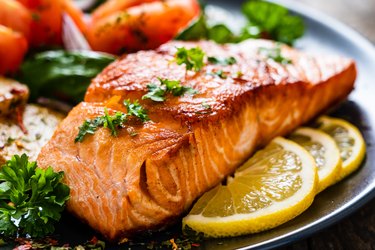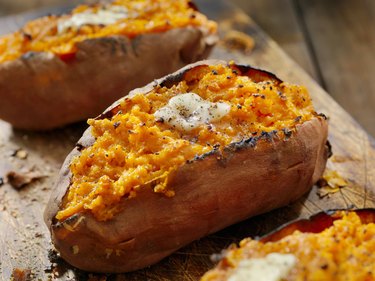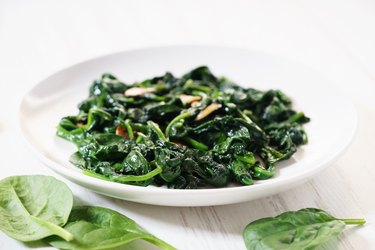Lots of skin-care products tout the benefits of vitamin E — but unlike the many bogus and misleading label claims out there, this one's actually backed by research.
The fat-soluble vitamin is a powerful antioxidant that protects your body's cells from the damaging effects of things like cigarette smoke, air pollution and ultraviolet light from the sun, according to the National Institutes of Health (NIH).
Video of the Day
Video of the Day
In other words, while vitamin E helps with preventing UV-induced free radical damage to the skin, it also provides anti-inflammatory benefits, per the Linus Pauling Institute. So yes, the nutrient can help you maintain good skin.
Vitamin E, also called alpha-tocopherol, supports a healthy immune system, too.
How Much Vitamin E Do You Need Per Day?
Adults need 15 milligrams of vitamin E per day, per the NIH.
Keep reading for a list of foods high in vitamin E, ranked by their Daily Value (DV) percentages. Note that the FDA's DV percentages are based on eating 15 milligrams of vitamin E per day.
Vegan Foods High in Vitamin E
1. Wheat Germ Oil: 20.3 mg, 135% Daily Value (DV)
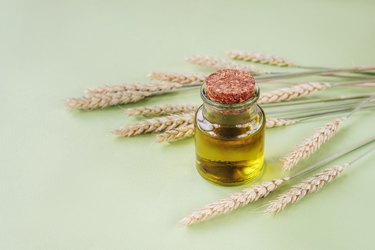
Wheat germ oil is extracted from the germ, which is part of the wheat plant. It's the best vegan food high in vitamin E, with an impressive 20.3 mg or 135 percent DV of the nutrient in one tablespoon. It also contains a healthy amount of anti-inflammatory omega-3s.
You can find wheat germ oil in health-food stores or online ($12.62 on Amazon.com). Note that it's best to refrigerate wheat germ oil to prevent the fats from going rancid.
2. Sunflower Seeds: 7.4 mg, 49% DV
If you've seen the movie Ace Ventura: Pet Detective, you know chewing sunflower seed shells and spitting them out onto a desk is a disgusting habit. But eating sunflower seeds is an excellent habit: Just 1 ounce contains 49 percent of the DV for vitamin E.
Like other nuts and seeds, sunflower seeds deliver plant-based protein (5.5 grams per ounce), fiber and healthy unsaturated fat. Choose the shelled variety to slow down your snacking speed for a more mindful eating experience.
3. Almonds: 7.3 mg, 49% DV
Out of all the nuts, almonds boast the highest levels of vitamin E, with 49 percent of the DV per 1-ounce serving. Almonds are filling, too, with 14 grams of healthy fat and 6 grams of protein per serving, making them the perfect snack or yogurt topper.
Eating almonds is linked to a decreased risk of heart disease because they help lower bad LDL cholesterol, per the Harvard T.H. Chan School of Public Health.
4. Hazelnuts: 4.3 mg, 28% DV
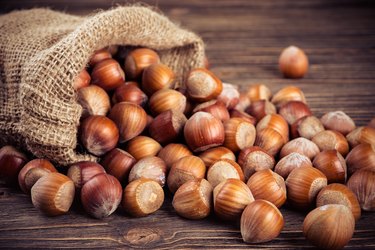
We know what you're thinking, and no, hazelnut-based Nutella is not a healthy snack. But hazelnuts are a tasty nut that provides 28 percent of the DV for vitamin E per ounce plus healthy fat, fiber and magnesium.
Toss this top food high in alpha-tocopherol with your favorite seeds and dried fruit for a nutrient-packed trail mix snack.
5. Avocado: 4.2 mg, 28% DV
Here's your friendly reminder that avocados are a fruit, and it's a fruit rich in vitamin E. One avocado contains 28 percent of the DV for vitamin E.
Your favorite toast topper is also high in heart-healthy fat, fiber, vitamin K and potassium. The fat in avocado will also help your body absorb vitamins E and K, which are fat-soluble. Try it in these creative avocado recipes.
6. Spinach: 3.7 mg, 25% DV
Various leafy greens, including cooked spinach, are your best bets for vegetables that are high in vitamin E. A 1-cup serving of Popeye's favorite meal contains 25 percent of the DV for vitamin E when cooked, while kale and Swiss chard are also rich sources of vitamin E.
Spinach also offers fiber, non-heme (plant-based) iron and magnesium.
7. Red Bell Pepper: 3.3 mg, 22% DV
Red bell peppers pack astronomical levels of vitamin C — 192 percent per 1-cup serving — and cooked red bell peppers are also high in vitamin E, with 22 percent of the DV per cup.
While all bell peppers contain antioxidants, the red variety has the most, per a March 2007 study in the Journal of Food Science.
8. Butternut Squash: 2.6 mg, 18% DV
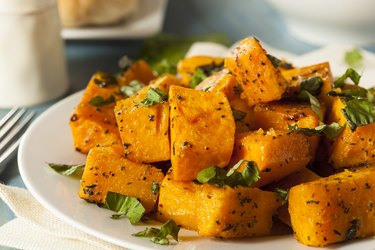
Butternut squash, a fall favorite, is known for its high levels of beta-carotene, or provitamin A, for healthy vision. The Thanksgiving staple is also a good source of vitamin E, with 18 percent of the DV per 1 cup cooked.
Because vitamins A and E are fat-soluble, cook it in olive oil to make sure your body soaks up the squash's nutrition. Try one of these protein-packed butternut squash meals.
9. Asparagus: 2.7 mg, 18% DV
A summer grilling favorite, asparagus provides 18 percent of the DV for vitamin E per 1 cup cooked. And while, yes, it might make your pee smell funny thanks to its asparagusic acid, the veggie is highly nutritious (and the smell isn't harmful at all).
Asparagus is also high in vitamin K and provides some vitamin A.
10. Kiwi: 2.6 mg, 18% DV
Kiwi is a sweet snack that gives you 18 percent of the DV for vitamin E and nearly 200 percent (!) of the DV for vitamin C in 1cup or about two whole fruits.
The green-fleshed fruit also contains fiber, vitamin K and potassium.
11. Broccoli: 2.3 mg, 15% DV
Of course, broccoli is on this list; it pretty much makes every good-for-you food list. A 1-cup serving of cooked broccoli has 15 percent of the DV for vitamin E, plus 183 percent of the DV for vitamin K and more than 100 percent of the DV for vitamin C.
12. Peanuts and Peanut Butter: 2 mg, 13% DV
Everyone's favorite snack, sandwich spread and dip, peanut butter has 13 percent of your DV for vitamin E in 2 tablespoons plus unsaturated fat, magnesium and protein. Similarly, an ounce of roaster peanuts has 9 percent of your DV.
Try one of these healthy peanut butter snacks to reap the benefits.
13. Olive Oil: 1.9 mg, 13% DV
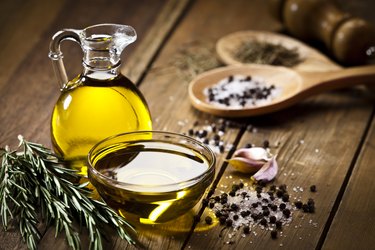
There's a reason olive oil is widely used in skin-care products: It contains the antioxidant vitamin E. But don't eat hand lotion — instead, cook with olive oil, or use it for dipping or a salad dressing. A 1-tablespoon serving has 13 percent of the DV for vitamin E.
Olive oil is also an excellent source of heart-healthy unsaturated fat, which is why it's the star ingredient in the Mediterranean Diet.
Animal-Based Foods High in Vitamin E
14. Trout: 4.7 mg, 32% DV
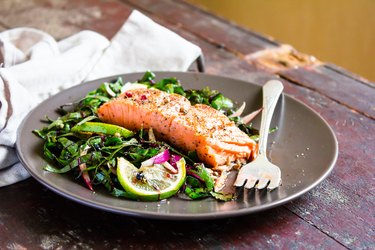
A 6-ounce filet of cooked rainbow trout provides 32 percent of your vitamin E DV. Pair your trout with a side of charred broccoli and a quinoa salad for a balanced meal.
15. Shrimp: 3.7 mg, 25% DV
Shrimp, like many shellfish, is a popular low-calorie, nutrient-dense food. A 6-ounce serving provides 25 percent of the DV for vitamin E, plus 38 grams of lean protein.
Seafood is also known for its high levels of vitamin B12, a key nutrient in maintaining healthy cell function. A 6-ounce serving provides more than 100 percent of the DV.
16. Salmon: 3.6 mg, 24% DV
A 6-ounce serving of canned salmon contains 24 percent of the DV for vitamin E, 195 percent of the DV for vitamin B12 and 89 percent of the DV for vitamin D, which is hard to find in foods.
Bonus: Canned salmon is lower in mercury than canned tuna and is sustainably wild-caught in Alaska, per the Environmental Defense Fund.
17. Goose: 2.9 mg, 20% DV
Roasted goose meat is a good source of vitamin E — a 6-ounce cooked portion has 20 percent of your DV. Goose is a game bird and has way more flavor (and fat) than chicken, so you might want to try adding it to your dinner rotation. You can buy goose at some butcher shops or online.
18. Eggs: 0.6 mg, 4% DV
Eggs aren't necessarily high in vitamin E — one large egg contains just 4 percent of your DV — but they do contribute a fair amount of the nutrient when you scramble two eggs for breakfast. The yolk contains all of the nutrient, so if your goal is to increase your vitamin E intake, skip the egg white omelets.
- National Institutes of Health: "Vitamin E"
- Linus Pauling Institute: "Vitamin E and Skin Health"
- Harvard T.H. Chan School of Public Health: "Almonds"
- Environmental Defense Fund: "Is Canned Tuna Safe?"
- Journal of Food Science: "Antioxidant Activities of Different Colored Sweet Bell Peppers (Capsicum annuum L.)"
- Nutrients: "Virgin Olive Oil and Health: Summary of the III International Conference on Virgin Olive Oil and Health Consensus Report, JAEN (Spain) 2018"
- National Institutes of Health: "Selenium"

